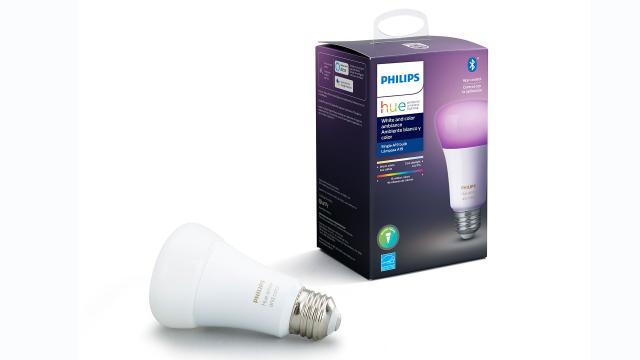Despite being one of the most popular smart light platforms on the market, one of the disadvantages of Philips’ Hue system is its need for a bridge. That means getting started with Hue tended to cost a bit more than competing platforms, because to control even one light, you needed a hub.
But with Philips’ new Hue with Bluetooth, Philips is making it even cheaper to smarten up your lights by letting users ditch the bridge. Now, instead of having to buy and set up a Philips Hue bridge, Hue with Bluetooth bulbs are essentially plug and play. Just screw in the bulb, turn the light on, and then connect the bulb to your phone using the new Philips Hue Bluetooth App (which is separate from the existing Philips Hue app).
Editor’s Note: The Phillips Hue with Bluetooth is not currently available in Australia, but it’s sure to land on our shores in future.
Even though these new Hue bulbs connect over Bluetooth instead of using a dedicated hub, you can still use many of Hue’s most important smart light features including being able to turn your lights on or off, adjust brightness, or change colours using the app, use pre-set scenes to change multiple lights at once, and allow for multi-user control.
And if you have a Google or Amazon-powered smart speaker in your home, you can connect the Hue with Bluetooth bulbs to your digital assistant of choice so you can control your lights using your voice.
However, compared to standard Hue lights, Hue with Bluetooth lights do have a number of restrictions. For Hue with Bluetooth, users can control a max of 10 lights at once while those with standard Hue lights can control up to 50 Hue lights per bridge. Additionally, Hue with Bluetooth lights can only be set up as one big room, instead of being able to assign lights to specific rooms such as your kitchen, bedroom, or office like you can with regular Hue lights.
And if you go even deeper, a lot of advanced functions such as being able to set timers and sleep routines, connect your smart lights to accessories like motion sensors and Hue-compatible wall switches, use Hue Sync to match the colour of your lights to whatever you’re watching, and more all require a Hue Bridge. And a real biggie for Apple smart home folks is that in order to use voice controls with HomeKit, Hue with Bluetooth won’t cut it, you’ll need a bridge for that.
Thankfully, for those who start out with Hue with Bluetooth, upgrading is as simple as buying a Hue bridge. From there, Philips will transition users to the standard app and help them connect their lights to the bridge instead of connecting via Bluetooth.
The other limitation for Hue with Bluetooth is that at launch, the only bulb styles you can choose from are A19 or BR30, which are available in white, white ambiance, and full colour for $US15 ($22), $US25 ($36), and $US50 ($72), respectively. Down the line, Philips says it plans on releasing more Hue with Bluetooth lights, but currently there’s no timetable for when that will happen.
At these prices, Hue with Bluetooth bulbs cost the same as standard Hue lights. so the real savings come from not having to buy a Hue bridge, which has a retail price of around $US50 ($72) depending on where you buy. Now you can spend more money on actual lights and see how you feel about smart lights without having to worry about how you’re supposed to connect everything together.
